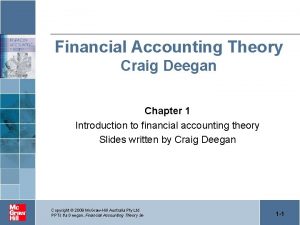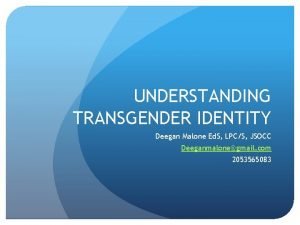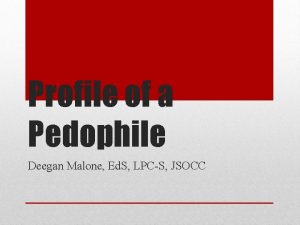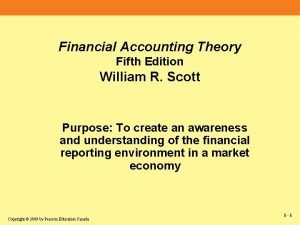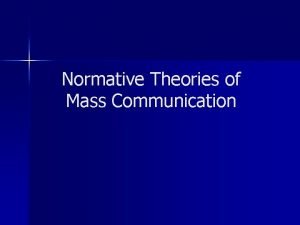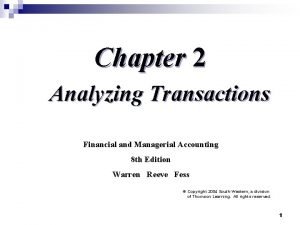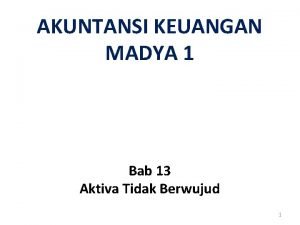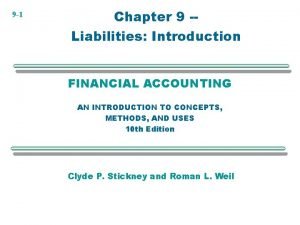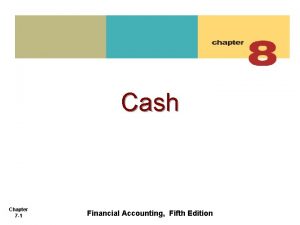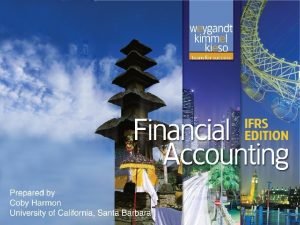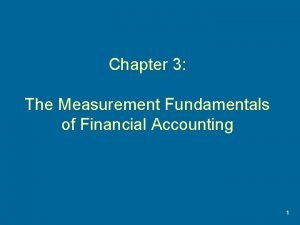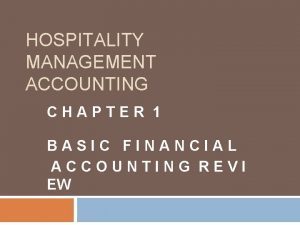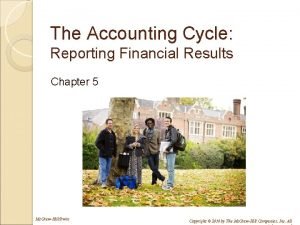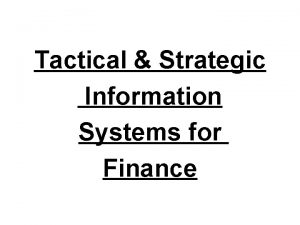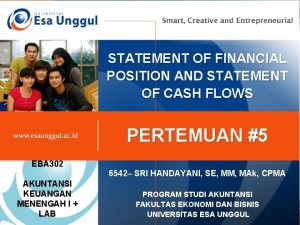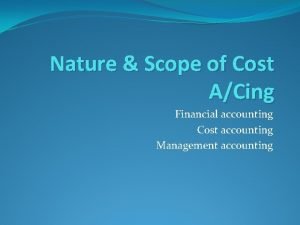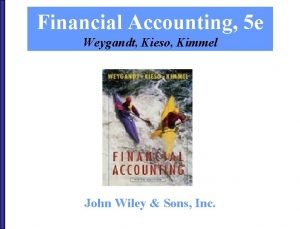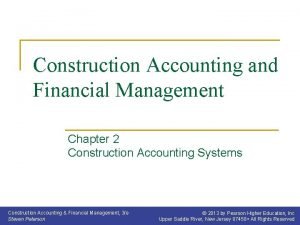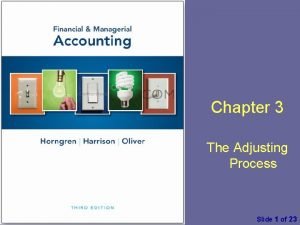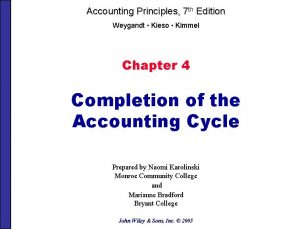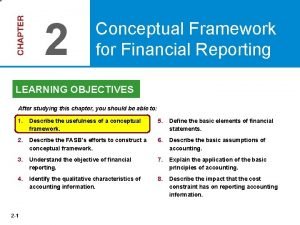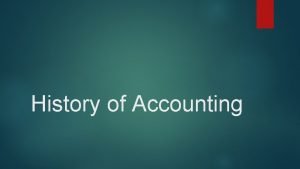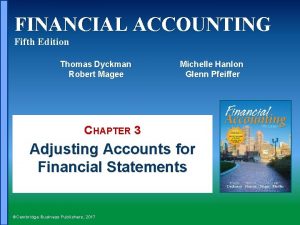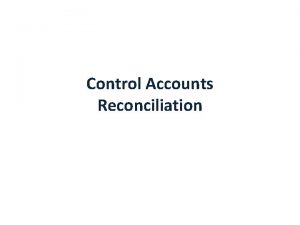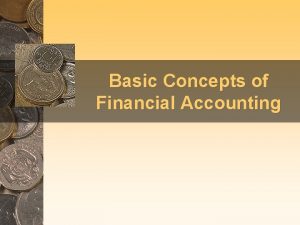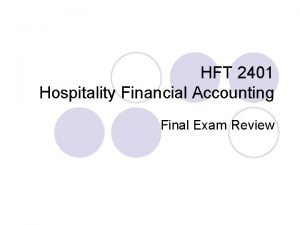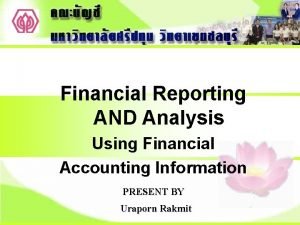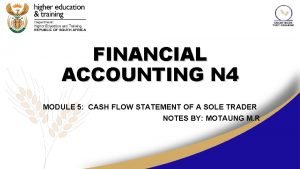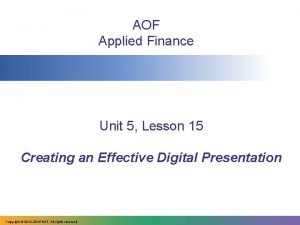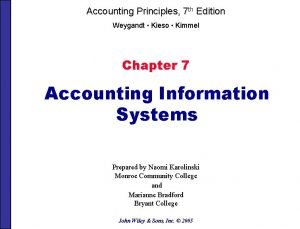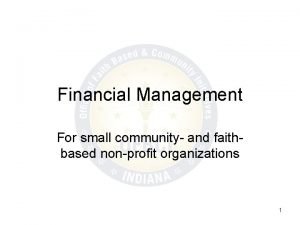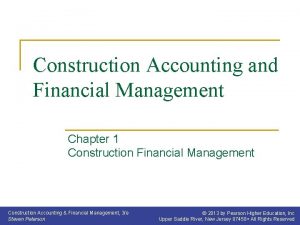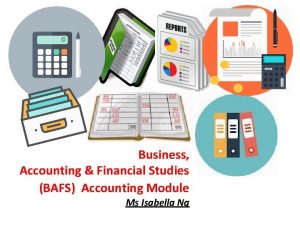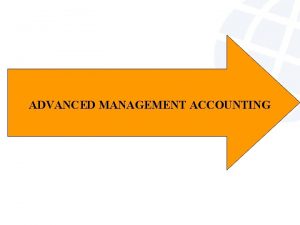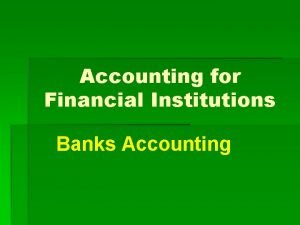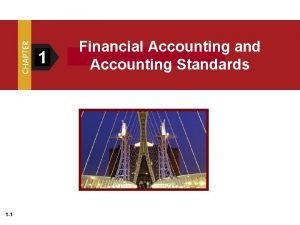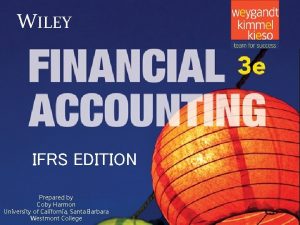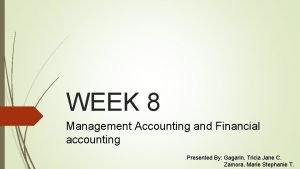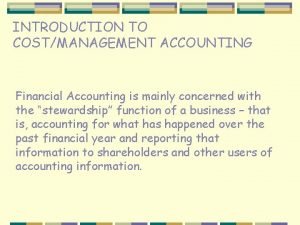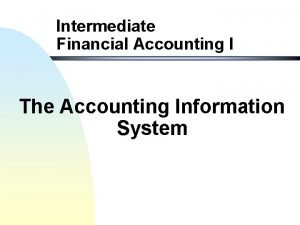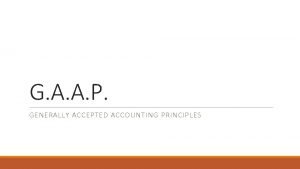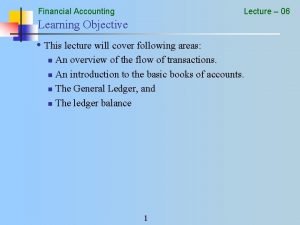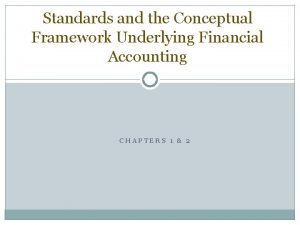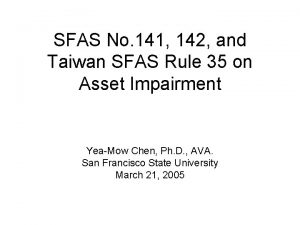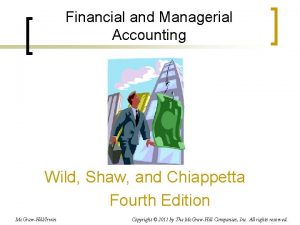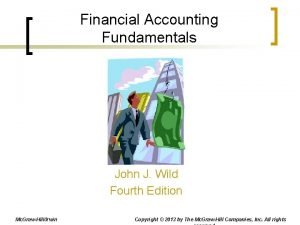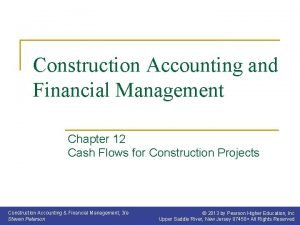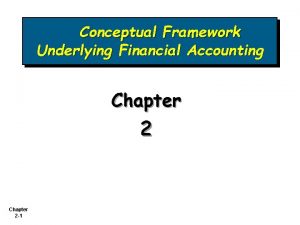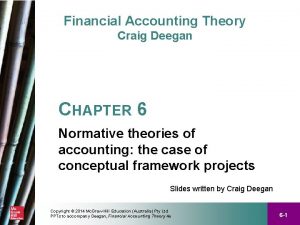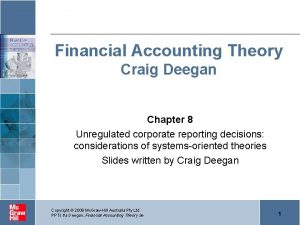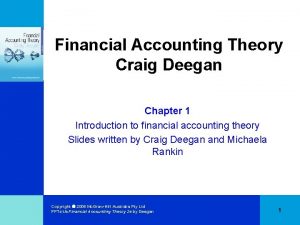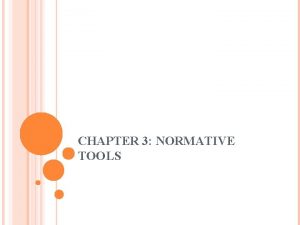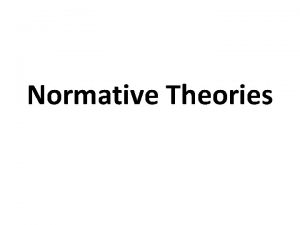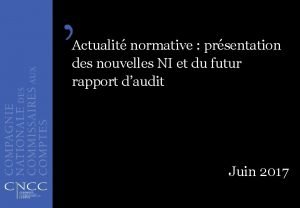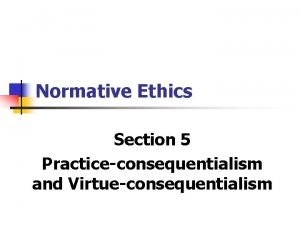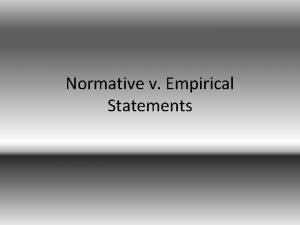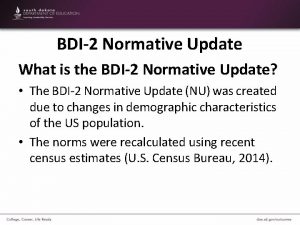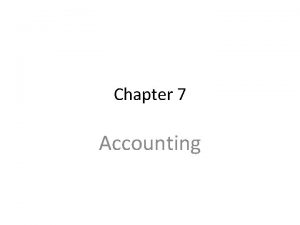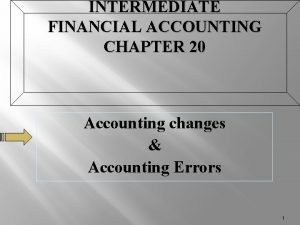Financial Accounting Theory Craig Deegan Chapter 6 Normative








































































- Slides: 72

Financial Accounting Theory Craig Deegan Chapter 6 Normative theories of accounting—the case of conceptual framework projects Slides written by Craig Deegan Copyright 2009 Mc. Graw-Hill Australia Pty Ltd PPTs t/a Deegan, Financial Accounting Theory 3 e 6 -1

Learning objectives • In this chapter you will be introduced to: – the role that conceptual frameworks (CFs) can play in the practice of financial reporting – the history of the development of the various existing conceptual framework projects – the various building blocks that have been developed within various conceptual framework projects Copyright 2009 Mc. Graw-Hill Australia Pty Ltd PPTs t/a Deegan, Financial Accounting Theory 3 e 6 -2

Learning objectives (cont. ) – perceived advantages and disadvantages that arise from the establishment and development of conceptual frameworks – recent initiatives being undertaken by the IASB and the FASB to develop an improved conceptual framework – factors, including political factors, that might help or hinder the development of conceptual framework projects – groups within society which are likely to benefit from the establishment and development of conceptual framework projects Copyright 2009 Mc. Graw-Hill Australia Pty Ltd PPTs t/a Deegan, Financial Accounting Theory 3 e 6 -3

What is a conceptual framework? • 'A coherent system of interrelated objectives and fundamentals that is expected to lead to consistent standards' (Statement of Financial Accounting Concepts No. 1: Objectives of Financial Reporting by Business Enterprises 1978) • Attempts to provide a structured theory of accounting Copyright 2009 Mc. Graw-Hill Australia Pty Ltd PPTs t/a Deegan, Financial Accounting Theory 3 e 6 -4

Conceptual frameworks as normative theories • Conceptual frameworks provide prescription so they are considered normative theories of accounting • 'Prescribes the nature, function and limits of financial accounting and reporting' (Statement of Financial Accounting Concepts No. 1: Objectives of Financial Reporting by Business Enterprises, 1978) Copyright 2009 Mc. Graw-Hill Australia Pty Ltd PPTs t/a Deegan, Financial Accounting Theory 3 e 6 -5

A revised conceptual framework • In recent years the FASB and IASB have been jointly working towards the development of an improved conceptual framework • In 2008 they released a document entitled: Exposure Draft of an improved Conceptual Framework for Financial Reporting • This phase of the project specifically addressed the objective of financial reporting and the qualitative characteristics and constraints of decision-useful financial reporting information. Copyright 2009 Mc. Graw-Hill Australia Pty Ltd PPTs t/a Deegan, Financial Accounting Theory 3 e 6 -6

Rationale for conceptual frameworks • To develop the practice of financial reporting logically and consistently we need to address such issues as: – what we mean by 'financial reporting' and what should be its scope; – which organisational characteristics indicate that an entity should produce financial reports; – the 'objective' of financial reporting; – qualitative characteristics financial information should possess; – what are the elements of financial reporting; and – what measurement rule should be employed. Copyright 2009 Mc. Graw-Hill Australia Pty Ltd PPTs t/a Deegan, Financial Accounting Theory 3 e 6 -7

Rationale for conceptual frameworks (cont. ) • Proponents argue that without agreement on these issues accounting standards will be developed in an ad hoc manner • Limited consistency between accounting standards in the absence of a conceptual framework Copyright 2009 Mc. Graw-Hill Australia Pty Ltd PPTs t/a Deegan, Financial Accounting Theory 3 e 6 -8

The 'building blocks' of the conceptual framework • The framework must be developed in a particular order – some issues (or assumptions) need to be resolved or made before moving on to subsequent 'building blocks' – One obvious issue that needs early agreement would be what is meant by 'financial reporting'. – Other issues that would also need agreement early in the process would be: § Definition of a reporting entity § Definition of the users of financial statements § The objective of financial reporting Copyright 2009 Mc. Graw-Hill Australia Pty Ltd PPTs t/a Deegan, Financial Accounting Theory 3 e 6 -9

The 'building blocks' of the conceptual framework (cont. ) • Because the rest of the framework flows from assumptions about the 'objective', if we reject the assumption, then we personally might be prepared to reject the prescriptions provided by the framework • Refer to Figure 6. 1 (p. 213) in the text for an overview of the IASB Framework for the Preparation and Presentation of Financial Statements (which in 2005 replaced the Australian Conceptual Framework) Copyright 2009 Mc. Graw-Hill Australia Pty Ltd PPTs t/a Deegan, Financial Accounting Theory 3 e 6 -10

History of the development of CFs • CFs were developed in a number of jurisdictions including – US, UK, Canada, Australia, New Zealand, International Accounting Standards Committee • In recent years many countries have adopted the IASB Framework given that they have decided to adopt the accounting standards released by the IASB • No standard-setters had developed a complete CF; measurement issues typically unaddressed • Limited or no progress in recent years, although there is now a joint IASB/FASB project to develop a new and improved conceptual framework Copyright 2009 Mc. Graw-Hill Australia Pty Ltd PPTs t/a Deegan, Financial Accounting Theory 3 e 6 -11

Development of frameworks of accounting in the US • 1961 and 1962: Moonitz, and Moonitz and Sprouse prescribed that accounting practice should be based on current values • 1965: Grady developed theory based on description of existing practice – led to the release of Accounting Principles Board (APB) Statement No. 4 – however, accounting profession under criticism for lack of any real framework Copyright 2009 Mc. Graw-Hill Australia Pty Ltd PPTs t/a Deegan, Financial Accounting Theory 3 e 6 -12

Development of frameworks of accounting in the US (cont. ) • Led to formation of Trueblood Committee in 1971 which produced Trueblood Report – report outlined 12 objectives of accounting and seven qualitative characteristics which financial information should possess – objective 1: focused on information needs of financial statement users – objective 2: need to serve users with limited ability to demand financial information Copyright 2009 Mc. Graw-Hill Australia Pty Ltd PPTs t/a Deegan, Financial Accounting Theory 3 e 6 -13

Development of frameworks of accounting in the US (cont. ) • 1974: APB replaced by FASB which then embarked on its CF project • Six Statements of Financial Accounting Concepts (SFACs) released from 1978 to 1985 • Initial SFACs normative in nature, but SFAC No. 5 relating to recognition and measurement largely descriptive of current practice – received much criticism – since 2005 FASB and IASB have been jointly working towards the development of a revised conceptual framework that would be used by both boards—referred to as the 'convergence project' Copyright 2009 Mc. Graw-Hill Australia Pty Ltd PPTs t/a Deegan, Financial Accounting Theory 3 e 6 -14

Development of a CF in the UK • Early moves towards guidance relating to objectives and identification of users provided by The Corporate Report (1976) – concerned with addressing the rights of the community in terms of their access to financial information (broader than notion of users adopted in other frameworks) – ultimately contents generally not accepted by the accounting profession Copyright 2009 Mc. Graw-Hill Australia Pty Ltd PPTs t/a Deegan, Financial Accounting Theory 3 e 6 -15

Development of a CF in the UK (cont. ) • 1991: ASB adopted the IASC's CF • IASC framework was generally consistent with the US and Australian frameworks—subsequently became known as the IASB Framework Copyright 2009 Mc. Graw-Hill Australia Pty Ltd PPTs t/a Deegan, Financial Accounting Theory 3 e 6 -16

Development of a CF in Australia • Degree of progression was slow • Only four Statements of Accounting Concepts (SACs) were released – SAC 1: Definition of the Reporting Entity – SAC 2: Objectives of General Purpose Financial Reporting – SAC 3: Qualitative Characteristics of Financial Information – SAC 4: Definition and Recognition of the Elements of Financial Statements Copyright 2009 Mc. Graw-Hill Australia Pty Ltd PPTs t/a Deegan, Financial Accounting Theory 3 e 6 -17

Development of a CF in Australia (cont. ) • Fifth SAC relating to measurement was never released • Had a number of similarities to the US CF project • 2005: Australia adopted the IASB Framework as a result of the decision by the Financial Reporting Council that Australia would adopt IAS/IFRS by 2005 • SAC 3 and SAC 4 were abandoned • SAC 1 and SAC 2 were retained until such time that a revised IASB Framework was developed Copyright 2009 Mc. Graw-Hill Australia Pty Ltd PPTs t/a Deegan, Financial Accounting Theory 3 e 6 -18

Current efforts of the IASB and the FASB • From 2005 the IASB and the FASB have been jointly working towards the development of a revised conceptual framework that will be used by both parties • The need for this revised framework has arisen because of the 'convergence project' in which the IASB and the FASB are working together to converge their two sets of accounting standards • Will take several years to complete Copyright 2009 Mc. Graw-Hill Australia Pty Ltd PPTs t/a Deegan, Financial Accounting Theory 3 e 6 -19

Current efforts of the IASB and the FASB (cont. ) • The IASB and FASB are undertaking the work on the conceptual framework in eight phases, these being: – – – objectives and qualitative characteristics definitions of elements recognition and de-recognition measurement reporting entity concept boundaries of financial reporting, and presentation and disclosure – purpose and status of the framework – application of the framework to not-for-profit entities – remaining issues, if any Copyright 2009 Mc. Graw-Hill Australia Pty Ltd PPTs t/a Deegan, Financial Accounting Theory 3 e 6 -20

Building blocks of the CF • The following discussion is based on the IASB Framework currently in place • Where appropriate, reference will also be made to current work being done by IASB and FASB given that this gives an indication of what might come in the future • Building blocks of the various CFs have addressed – – – definition of the reporting entity objectives of general purpose financial reporting (GPFR) perceived users of GPFRs qualitative characteristics that GPFRs should possess elements of financial statements possible approaches to measuring the elements Copyright 2009 Mc. Graw-Hill Australia Pty Ltd PPTs t/a Deegan, Financial Accounting Theory 3 e 6 -21

Definition of the reporting entity • The Conceptual Framework provides a definition of entities required to produce GPFRs – known as reporting entities Copyright 2009 Mc. Graw-Hill Australia Pty Ltd PPTs t/a Deegan, Financial Accounting Theory 3 e 6 -22

General purpose financial reports • GPFRs are defined as reports – '… intended to meet the information needs common to users who are unable to command the preparation of reports tailored so as to satisfy, specifically, all of their information needs' (SAC 1, para. 6) • GPFRs are reports that comply with accounting standards and other generally accepted accounting practices (GAAPs) Copyright 2009 Mc. Graw-Hill Australia Pty Ltd PPTs t/a Deegan, Financial Accounting Theory 3 e 6 -23

Special purpose financial reports • By contrast, special purpose reports are provided to meet the information demands of a particular user, or group of users Copyright 2009 Mc. Graw-Hill Australia Pty Ltd PPTs t/a Deegan, Financial Accounting Theory 3 e 6 -24

Entities required to produce GPFRs • Not all entities are classed as reporting entities • SAC 1 states that GPFRs should be prepared when there are users: – '… whose information needs have common elements, and those users cannot command the preparation of information to satisfy their individual information needs' (para. 8) Copyright 2009 Mc. Graw-Hill Australia Pty Ltd PPTs t/a Deegan, Financial Accounting Theory 3 e 6 -25

Factors indicative of a reporting entity (SAC 1) • Separation of management from those with an economic interest in the entity • The economic or political importance/influence of the entity to/on other parties • The financial characteristics of the entity Copyright 2009 Mc. Graw-Hill Australia Pty Ltd PPTs t/a Deegan, Financial Accounting Theory 3 e 6 -26

Objectives of GPFR • Traditional objective was to enable outsiders to assess the stewardship of management • Recent commonly accepted goal of financial reporting is to assist report users' economic decision making – less emphasis placed on the stewardship function Copyright 2009 Mc. Graw-Hill Australia Pty Ltd PPTs t/a Deegan, Financial Accounting Theory 3 e 6 -27

Objective embraced within CFs • Objective of GPFRs in SAC 2 is deemed to be – to provide information to users that is useful for making and evaluating decisions about the allocation of scarce resources • Objective of decision usefulness calls into question usefulness of historical cost information Copyright 2009 Mc. Graw-Hill Australia Pty Ltd PPTs t/a Deegan, Financial Accounting Theory 3 e 6 -28

Other objectives of GPFRs • Another objective is to enable reporting entities to demonstrate accountability between the entity and those parties to which the entity is deemed accountable • Accountability is defined as – the duty to provide an account or reckoning of those actions for which one is held responsible • Accountability is not generally embraced by CFs Copyright 2009 Mc. Graw-Hill Australia Pty Ltd PPTs t/a Deegan, Financial Accounting Theory 3 e 6 -29

Current thinking of the IASB and FASB • In the 2008 conceptual framework exposure draft it is stated: – The objective of general purpose financial reporting is to provide financial information about the reporting entity that is useful to present and potential equity investors, lenders and other creditors in making decisions in their capacity as capital providers. Information that is decisionuseful to capital providers may also be useful to other users of financial reporting who are not capital providers. Copyright 2009 Mc. Graw-Hill Australia Pty Ltd PPTs t/a Deegan, Financial Accounting Theory 3 e 6 -30

Current thinking of the IASB and FASB (cont. ) • As we know from previous lectures, before we are prepared to accept the prescriptions provided by a normative theory we must be satisfied with the underlying assumptions made • Hence, if we reject the assumptions about the objective of general purpose financial reporting then we would be inclined to reject the prescriptions made despite how logical the framework may appear • Is this objective (above) too restrictive? Copyright 2009 Mc. Graw-Hill Australia Pty Ltd PPTs t/a Deegan, Financial Accounting Theory 3 e 6 -31

Users of financial reports • SAC 2 identifies three primary user groups for GPFRs – resource providers § employees, lenders, creditors, suppliers, investors and contributors – recipients of goods and services § customers and beneficiaries – parties performing review or oversight function § parliaments, governments, regulatory agencies, analysts, labour unions, employer groups, media and special interest groups Copyright 2009 Mc. Graw-Hill Australia Pty Ltd PPTs t/a Deegan, Financial Accounting Theory 3 e 6 -32

International perspectives on users of GPFRs • The IASB Framework – identifies GPFRs users as investors, employees, lenders, suppliers, customers, govt. agencies and the public – states that information designed to meet the needs of investors will usually meet the needs of the other groups • US: SFAC 1 – main focus is present and potential investors and other users with either a direct financial interest or related to those with a direct financial interest • UK: The Corporate Report – all groups impacted by an organisation's operations have rights to information about the reporting entity, not necessarily related to resource allocation decisions Copyright 2009 Mc. Graw-Hill Australia Pty Ltd PPTs t/a Deegan, Financial Accounting Theory 3 e 6 -33

Level of expertise expected of financial report readers • Generally accepted that readers are expected to have some proficiency in financial accounting • IASB Framework (para. 25) – … users are assumed to have a reasonable knowledge of business and economic activities and accounting and a willingness to study the information with reasonable diligence Copyright 2009 Mc. Graw-Hill Australia Pty Ltd PPTs t/a Deegan, Financial Accounting Theory 3 e 6 -34

Current thinking of the IASB and the FASB in relation to 'users' • The 2008 exposure draft stated: – The primary user group includes both present and potential equity investors, lenders and other creditors, regardless of how they obtained, or will obtain, their interests…. Other users who have specialised needs, such as suppliers, customers and employees (when not acting as capital providers), as well as governments and their agencies and members of the public, may also find useful the information that meets the needs of capital providers; however, financial reporting is not primarily directed to these other groups because capital providers have more direct and immediate needs • Is this perspective of 'users' too restrictive? Copyright 2009 Mc. Graw-Hill Australia Pty Ltd PPTs t/a Deegan, Financial Accounting Theory 3 e 6 -35

Qualitative characteristics of financial reports • To ensure financial information is useful for economic decision making, we need to consider the attributes or qualities that financial information should have • According to IASB Framework – primary qualitative characteristics are understandability, relevance, reliability and comparability – related to relevance is materiality – IASB Framework appears to give greater prominence to relevance and reliability – there are issues associated with the 'trade-off' between relevance and reliability Copyright 2009 Mc. Graw-Hill Australia Pty Ltd PPTs t/a Deegan, Financial Accounting Theory 3 e 6 -36

Reliability • Information is considered to be reliable if it 'faithfully represents' the entity's transactions and events • Should be free from bias and undue error • Reliability is a function of representational faithfulness, verifiability and neutrality Copyright 2009 Mc. Graw-Hill Australia Pty Ltd PPTs t/a Deegan, Financial Accounting Theory 3 e 6 -37

Reliability—implications for traditional accounting • Traditionally, the doctrine of conservatism and the acceptance of 'prudence' has been adopted – bias towards understating asset values and overstating liabilities • This doctrine is not consistent with notions of reliability or freedom from bias Copyright 2009 Mc. Graw-Hill Australia Pty Ltd PPTs t/a Deegan, Financial Accounting Theory 3 e 6 -38

Relevance • Something is relevant if it influences decisions on the allocation of scarce resources – if it is capable of making a difference in a decision • For information to be relevant it should have: – predictive value, and – feedback value Copyright 2009 Mc. Graw-Hill Australia Pty Ltd PPTs t/a Deegan, Financial Accounting Theory 3 e 6 -39

Materiality • A limiting factor on the disclosure of relevant and reliable material is the notion of materiality • An item is material if (IASB Framework, para. 30) –. . . its omission or misstatement could influence the economic decisions of users taken on the basis of the financial statements …. Materiality provides a cut-off rather than being a primary qualitative characteristic which information must have if it is to be useful Copyright 2009 Mc. Graw-Hill Australia Pty Ltd PPTs t/a Deegan, Financial Accounting Theory 3 e 6 -40

Uniformity and consistency • Uniformity and consistency imply advantages in restricting the number of accounting methods that can be used by reporting entities – has been argued that firms adopt particular accounting methods because they best reflect their underlying performance – restricting available methods imposes costs on reporting entities Copyright 2009 Mc. Graw-Hill Australia Pty Ltd PPTs t/a Deegan, Financial Accounting Theory 3 e 6 -41

Costs vs. benefits • Need to consider whether the cost of providing certain information exceeds the benefits to be derived from its provision – costs include collection, storage, retrieval, presentation, analysis and interpretation – benefits come from sound economic decision making by users • Measuring potential costs and benefits involves professional judgement Copyright 2009 Mc. Graw-Hill Australia Pty Ltd PPTs t/a Deegan, Financial Accounting Theory 3 e 6 -42

Latest thinking of the IASB and the FASB regarding qualitative characteristics • In the 2008 exposure draft released as part of the conceptual framework project it is stated: – For financial information to be useful, it must possess two fundamental qualitative characteristics—relevance and faithful representation. • The draft conceptual framework has reduced the four 'primary qualitative characteristics' to two 'fundamental qualitative characteristics' Copyright 2009 Mc. Graw-Hill Australia Pty Ltd PPTs t/a Deegan, Financial Accounting Theory 3 e 6 -43

Latest thinking of the IASB and the FASB regarding qualitative characteristics (cont. ) • The qualitative characteristic of reliability was replaced by 'faithfully representation' • The other two primary qualitative characteristics identified in the IASB Framework, these being understandability and comparability, have been renamed as 'enhancing qualitative characteristics' in the draft document released by the IASB • Two additional 'enhancing qualitative characteristics' have also been included (thereby giving a total of four enhancing qualitative characteristics), these being verifiability and timeliness Copyright 2009 Mc. Graw-Hill Australia Pty Ltd PPTs t/a Deegan, Financial Accounting Theory 3 e 6 -44

Can GPFRs provide unbiased accounts of performance? • The practice of accounting is heavily reliant on professional judgement • Prior to accounting standards being released, standard-setters attempt to determine the economic consequences of following the standards – if they consider economic consequences then standards cannot be considered objective or neutral Copyright 2009 Mc. Graw-Hill Australia Pty Ltd PPTs t/a Deegan, Financial Accounting Theory 3 e 6 -45

Can GPFRs provide unbiased accounts of performance? (cont. ) • If we accept the notion that preparers will be driven by self-interest (from Positive Accounting Theory) notions of objectivity or neutrality are unrealistic • Political nature of standard setting process also affects neutrality and objectivity • In communicating reality accountants construct reality (Hines 1988) – That is, if accountants identify something and start to place a monetary value on it then it gains importance – it becomes visible (and 'real') – Conversely, if accountants ignore it – such as many externalities caused by business entities – then for many people the 'issue' does not exist Copyright 2009 Mc. Graw-Hill Australia Pty Ltd PPTs t/a Deegan, Financial Accounting Theory 3 e 6 -46

The elements of financial reporting • The next building block considers the definition and recognition criteria of the elements of financial reporting • Definition criteria—what attributes are required before an item can be considered as belonging to a particular class of element • Recognition criteria—employed to determine whether the item can be included in the financial statements Copyright 2009 Mc. Graw-Hill Australia Pty Ltd PPTs t/a Deegan, Financial Accounting Theory 3 e 6 -47

Five elements of financial reporting in the IASB Framework • • • Assets Liabilities Equity Expenses Income – in the IASB Framework, income is further subdivided into revenues and gains – ten elements identified in the US by FASB Copyright 2009 Mc. Graw-Hill Australia Pty Ltd PPTs t/a Deegan, Financial Accounting Theory 3 e 6 -48

Definition of assets • '… a resource controlled by the entity as a result of past events and from which future economic benefits are expected to flow to the entity' (IASB Framework, para. 49(a)) • Three key characteristics – must be an expected future economic benefit – the reporting entity must control the future economic benefit – the transaction or other past event giving rise to the reporting entity's control must have occurred Copyright 2009 Mc. Graw-Hill Australia Pty Ltd PPTs t/a Deegan, Financial Accounting Theory 3 e 6 -49

Definition of assets (cont. ) • The definition refers to the benefit and not its source – in the absence of future economic benefits, the object or right will not qualify as an asset • The benefits can result from ongoing use, not necessarily a value in exchange Copyright 2009 Mc. Graw-Hill Australia Pty Ltd PPTs t/a Deegan, Financial Accounting Theory 3 e 6 -50

The characteristic of control • Control relates to the capacity to benefit from the asset and to deny or regulate others' access to the benefit • Legal enforceability is not a prerequisite for establishing the existence of control – control (and not legal ownership) is required, although controlled assets are frequently owned Copyright 2009 Mc. Graw-Hill Australia Pty Ltd PPTs t/a Deegan, Financial Accounting Theory 3 e 6 -51

Recognition of assets • An asset—and all the other elements of accounting —shall be recognised when – it is probable that any future economic benefit associated with the item will flow to or from the entity, and – the item has a cost or value that can be measured with reliability (IASB Framework, para. 83) • Probable is generally considered to mean 'more likely rather than less likely' Copyright 2009 Mc. Graw-Hill Australia Pty Ltd PPTs t/a Deegan, Financial Accounting Theory 3 e 6 -52

'Current thinking' of the IASB and FASB in relation to assets • Within the 2008 exposure draft the IASB and FASB thought there were shortcomings with the existing asset definition. They stated: – Some users misinterpret the terms 'expected' (IASB definition) and 'probable' (FASB definition) to mean that there must be a high likelihood of future economic benefits for the definition to be met; this excludes asset items with a low likelihood of future economic benefits. – The definitions place too much emphasis on identifying the future flow of economic benefits, instead of focusing on the item that presently exists, an economic resource. – Some users misinterpret the term 'control' and use it in the same sense as that used for purposes of consolidation accounting. The term should focus on whether the entity has some rights or privileged access to the economic resource. – The definitions place undue emphasis on identifying the past transactions or events that gave rise to the asset, instead of focusing on whether the entity had access to the economic resource at the balance sheet date. Copyright 2009 Mc. Graw-Hill Australia Pty Ltd PPTs t/a Deegan, Financial Accounting Theory 3 e 6 -53

Current thinking about assets (cont. ) • The IASB and FASB developed the following draft definition: – An asset of an entity is a present economic resource to which, through an enforceable right or other means, the entity has access or can limit the access of others • This definition also seems to have limitations • Some of the above terms seem rather ambiguous Copyright 2009 Mc. Graw-Hill Australia Pty Ltd PPTs t/a Deegan, Financial Accounting Theory 3 e 6 -54

Definition of liabilities • A liability is presently defined as – '… a present obligation of the entity arising from past events, the settlement of which is expected to result in an outflow from the entity of resources embodying economic benefits' (IASB Framework, para. 49(b)) – present obligations not only refers to legally enforceable obligations but also those imposed by notions of equity and fairness, or by custom or other business practices Copyright 2009 Mc. Graw-Hill Australia Pty Ltd PPTs t/a Deegan, Financial Accounting Theory 3 e 6 -55

Recognition of liabilities • Recognition criteria consistent with those of assets and the other elements of accounting • A liability shall be recognised when: – it is probable that the sacrifice of economic benefits will be required, and – the amount of the liability can be measured reliably • Has implications for disclosure of various provisions Copyright 2009 Mc. Graw-Hill Australia Pty Ltd PPTs t/a Deegan, Financial Accounting Theory 3 e 6 -56

Present thinking of the IASB and FASB in relation to liabilities • According to the exposure draft released in 2008 the IASB and FASB believe that the existing liability definition has limitations: – Some users misinterpret the terms 'expected' (IASB definition) and 'probable' (FASB definition) to mean that there must be a high likelihood of future outflow of economic benefits for the definition to be met; this excludes liability items with a low likelihood of a future outflow of economic benefits – The definitions place too much emphasis on identifying the future outflow of economic benefits, instead of focusing on the item that presently exists, an economic obligation – The definitions place undue emphasis on identifying the past transactions or events that gave rise to the liability, instead of focusing on whether the entity has an economic obligation at the reporting date Copyright 2009 Mc. Graw-Hill Australia Pty Ltd PPTs t/a Deegan, Financial Accounting Theory 3 e 6 -57

Present thinking of the IASB and FASB in relation to liabilities (cont. ) • The IASB and FASB proposed the following draft definition of a liability: – A liability of an entity is a present economic obligation that is enforceable against the entity. • As with the proposed definition of assets, the suggested change in the liability definition could potentially have significant implications for financial reporting. For example: – The above definition could act to exclude constructive or equitable obligations that are not enforceable against the entity. This would be a major departure from existing practice – Would this be a good change? Copyright 2009 Mc. Graw-Hill Australia Pty Ltd PPTs t/a Deegan, Financial Accounting Theory 3 e 6 -58

Approaches to determining profit • Two common approaches to determining profits – asset/liability approach links profit to changes in assets and liabilities – revenue/expense approach relies on concepts such as the matching principle • The definition of expenses and revenues in the CF based on asset/liability perspective Copyright 2009 Mc. Graw-Hill Australia Pty Ltd PPTs t/a Deegan, Financial Accounting Theory 3 e 6 -59

Definition of expenses • '… decreases in economic benefits during the accounting period in the form of outflows or depletions of assets or incurrences of liabilities that result in decreases in equity, other than those relating to distributions to equity participants' (IASB Framework, para. 70(b)) Copyright 2009 Mc. Graw-Hill Australia Pty Ltd PPTs t/a Deegan, Financial Accounting Theory 3 e 6 -60

Recognition of expenses • An expense shall be recognised when – it is probable that the consumption or loss of future economic benefits resulting in a reduction in assets and/or an increase in liabilities has occurred, and – the consumption or loss of economic benefits can be measured reliably Copyright 2009 Mc. Graw-Hill Australia Pty Ltd PPTs t/a Deegan, Financial Accounting Theory 3 e 6 -61

Definition of income • '… increases in economic benefits during the accounting period in the form of inflows or enhancements of assets or decreases of liabilities that result in increases in equity, other than those relating to contributions from equity participants' (SAC 4, para. 70(a)) Copyright 2009 Mc. Graw-Hill Australia Pty Ltd PPTs t/a Deegan, Financial Accounting Theory 3 e 6 -62

Definition of income (cont. ) • Income can be recognised from normal trading relations, as well as from non-reciprocal transfers such as grants, donations, bequests or where liabilities are forgiven • IASB Framework further subdivides income into revenues and gains – revenue arises in the course of the ordinary activities of an entity – gains represent other items that meet the definition of income and may, or may not, arise in the ordinary activities of an enterprise – not clear why there is a need to break income into two components Copyright 2009 Mc. Graw-Hill Australia Pty Ltd PPTs t/a Deegan, Financial Accounting Theory 3 e 6 -63

Recognition of income • As with the other elements of accounting, income is recognised when: – it is probable that the inflow or other enhancement or saving in outflows of future economic benefits has occurred; and – the inflow or other enhancement or saving in outflows of future economic benefits can be measured reliably. Copyright 2009 Mc. Graw-Hill Australia Pty Ltd PPTs t/a Deegan, Financial Accounting Theory 3 e 6 -64

Definition of equity • Equity is defined as 'the residual interest in the assets of the entity after deducting all of its liabilities' (IASB Framework, para. 49(c)) • As a residual interest it ranks after liabilities in terms of claims against the assets • Definition is a direct function of the definitions of assets and liabilities Copyright 2009 Mc. Graw-Hill Australia Pty Ltd PPTs t/a Deegan, Financial Accounting Theory 3 e 6 -65

Measurement principles • To date there is very little prescription in relation to measurement provided by CFs • FASB statement provides description of various approaches to measuring elements without providing prescription Copyright 2009 Mc. Graw-Hill Australia Pty Ltd PPTs t/a Deegan, Financial Accounting Theory 3 e 6 -66

Current IASB and FASB work on measurement issues • In 2005 the IASB and FASB stated: – Measurement is one of the most underdeveloped areas of the two frameworks. . . Both frameworks (the IASB and FASB Frameworks) contain lists of measurement attributes used in practice. The lists are broadly consistent, comprising historical cost, current cost, gross or net realizable (settlement) value, current market value, and present value of expected future cash flows. Both frameworks indicate that use of different measurement attributes is expected to continue. However, neither provides guidance on how to choose between the listed measurement attributes or consider other theoretical possibilities. In other words, the frameworks lack fully developed measurement concepts. Copyright 2009 Mc. Graw-Hill Australia Pty Ltd PPTs t/a Deegan, Financial Accounting Theory 3 e 6 -67

Current IASB and FASB work on measurement issues (cont. ) • Phase C of the joint IASB and FASB Conceptual Framework Project is to address measurement issues. In this work the IASB and FASB have identified nine potential measurement bases, these being: past entry price, past exit price, modified past amount, current entry price, current exit price, current equilibrium price, value in use, future entry price, and future exit price • It is expected that it will be a number of years before any conclusion is reached about the most appropriate measurement basis for assets and liabilities Copyright 2009 Mc. Graw-Hill Australia Pty Ltd PPTs t/a Deegan, Financial Accounting Theory 3 e 6 -68

Benefits associated with conceptual frameworks • Accounting standards should be more consistent and logical • Increased international compatibility of accounting standards • Standard-setters should be more accountable for their decisions • Communication between standard-setters and their constituents should be enhanced Copyright 2009 Mc. Graw-Hill Australia Pty Ltd PPTs t/a Deegan, Financial Accounting Theory 3 e 6 -69

Benefits associated with CFs (cont. ) • The development of accounting standards should be more economical • Where conceptual frameworks cover a particular issue, there might be a reduced need for additional standards • Emphasise the 'decision usefulness' role of financial reports rather than restricting concern to stewardship Copyright 2009 Mc. Graw-Hill Australia Pty Ltd PPTs t/a Deegan, Financial Accounting Theory 3 e 6 -70

Disadvantages of conceptual frameworks • Smaller organisations may feel overburdened by reporting requirements • Typically economic in focus, so ignore transactions that have not involved market transactions or exchange of property rights – further reinforces the importance of economic performance relative to social performance • Represent a codification of existing practice Copyright 2009 Mc. Graw-Hill Australia Pty Ltd PPTs t/a Deegan, Financial Accounting Theory 3 e 6 -71

CFs as a means of legitimising standard-setting bodies • Some (e. g. Hines and Solomons) have suggested that CFs have been used as devices to help ensure the ongoing existence of the accounting profession • Increase the ability of the profession to selfregulate, thus counteracting government intervention Copyright 2009 Mc. Graw-Hill Australia Pty Ltd PPTs t/a Deegan, Financial Accounting Theory 3 e 6 -72
 Deegan financial accounting theory
Deegan financial accounting theory Normative theory of accounting
Normative theory of accounting Financial accounting and accounting standards chapter 1
Financial accounting and accounting standards chapter 1 Deegan malone
Deegan malone Harvard gmas
Harvard gmas Social and environmental accounting ppt
Social and environmental accounting ppt Financial accounting theory scott
Financial accounting theory scott Normative ethical theory examples
Normative ethical theory examples Normative theories of communication
Normative theories of communication Normative ethical theory examples
Normative ethical theory examples Normative sponsorship theory
Normative sponsorship theory 8 normative theory of communication
8 normative theory of communication Theories of the press
Theories of the press Chapter 2 solutions managerial accounting
Chapter 2 solutions managerial accounting Financial accounting chapter 13
Financial accounting chapter 13 Financial accounting chapter 6
Financial accounting chapter 6 Financial accounting chapter 9
Financial accounting chapter 9 Financial accounting chapter 7
Financial accounting chapter 7 Financial accounting ifrs 4th edition chapter 12
Financial accounting ifrs 4th edition chapter 12 Financial accounting chapter 3
Financial accounting chapter 3 Owner's equity statement
Owner's equity statement Financial accounting chapter 1
Financial accounting chapter 1 Financial accounting chapter 5
Financial accounting chapter 5 Financial motivators
Financial motivators Tactical information systems
Tactical information systems Statement of financial position classification
Statement of financial position classification Definition of management accounting
Definition of management accounting Nature of cost accounting
Nature of cost accounting Management accounting nature
Management accounting nature Kimmel accounting tools 5e
Kimmel accounting tools 5e Construction cost accounting basics
Construction cost accounting basics Income statement in financial accounting
Income statement in financial accounting Unit 5 lesson 2 financial accounting
Unit 5 lesson 2 financial accounting Unit 5 lesson 2 financial accountings
Unit 5 lesson 2 financial accountings Kimmel financial accounting 7the edition
Kimmel financial accounting 7the edition Conceptual framework in financial accounting
Conceptual framework in financial accounting Father of management accounting
Father of management accounting Financial accounting dyckman
Financial accounting dyckman Control account number
Control account number Financial accounting kimmel ch1-2
Financial accounting kimmel ch1-2 Basic concepts of accounting and finance
Basic concepts of accounting and finance Importance of financial accounting
Importance of financial accounting Unit 13 accounting and financial statements
Unit 13 accounting and financial statements Objective of financial accounting
Objective of financial accounting Cost of goods manufactured formula
Cost of goods manufactured formula Financial accounting final exam multiple choice
Financial accounting final exam multiple choice Using financial accounting information 10th edition
Using financial accounting information 10th edition Cash flow structure
Cash flow structure Appendix g financial accounting
Appendix g financial accounting Unit 5 lesson 2 financial accounting
Unit 5 lesson 2 financial accounting Kimmel financial accounting 7e
Kimmel financial accounting 7e Which item is a constraint in financial accounting
Which item is a constraint in financial accounting Financial management software for faith-based organizations
Financial management software for faith-based organizations Construction accounting and financial management
Construction accounting and financial management Nss business accounting and financial studies
Nss business accounting and financial studies Management accounts definition
Management accounts definition Financial institutions accounting
Financial institutions accounting Financial accounting standards
Financial accounting standards Ifrs
Ifrs External and internal users of accounting information
External and internal users of accounting information Bookkeeping is mainly concerned with
Bookkeeping is mainly concerned with Accounts payable subsidiary ledger
Accounts payable subsidiary ledger Drawback of financial accounting
Drawback of financial accounting Materiality concept
Materiality concept Objectives of financial accounting
Objectives of financial accounting Fasb conceptual framework
Fasb conceptual framework Fasb 142
Fasb 142 Financial and managerial accounting wild
Financial and managerial accounting wild Financial accounting wild
Financial accounting wild Construction accounting and financial management
Construction accounting and financial management Third level of conceptual framework
Third level of conceptual framework Computerized accounting software
Computerized accounting software Accountin principles
Accountin principles
